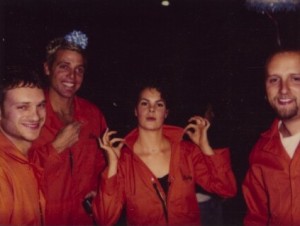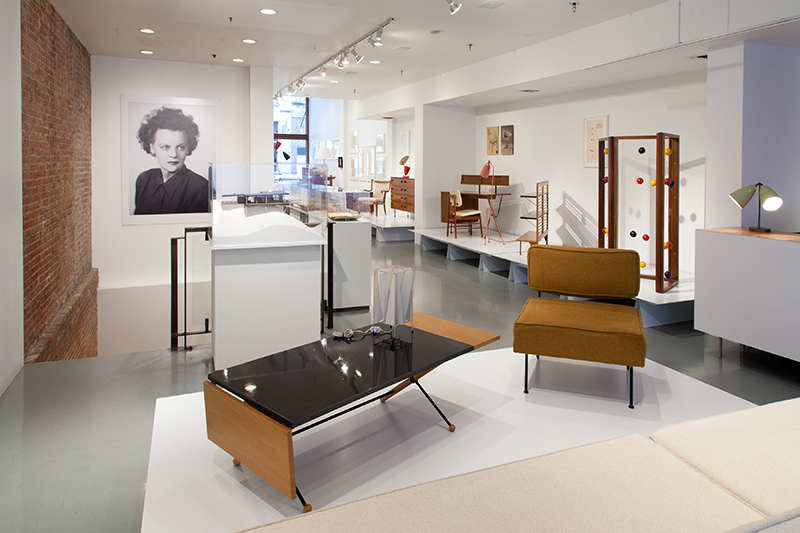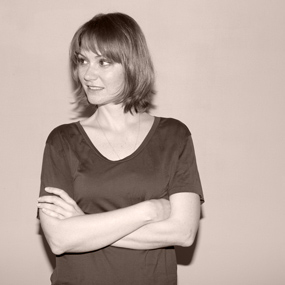Six Questions for Evan Snyderman & Zesty Meyers
Gallery Spotlight: R & Company
-
Evan Snyderman (left) and Zesty Meyers
Courtesy of R & Company
-
What's the Matter? exhibition
Courtesy of R & Company
-
What's the Matter? exhibition
Courtesy of R & Company
-
Rock Stools by Why Design
Courtesy of R & Company
-
Metal Pillow by Why Design
Courtesy of R & Company
-
Ring sculptures by Hugo Franca
Courtesy of R & Company
-
Lounge chair by Bae Sehwa
Courtesy of R & Company
-
What's the Matter? exhibition concept
Courtesy of R & Company
Evan Snyderman and Zesty Meyers of New York's R & Company gallery believe that the objects you live with should be unique—personalized, inimitable embodiments of their creators’ signatures. It's for this reason that they specialize in both vintage and contemporary objects at the intersection of design and craft. Their roster of talents includes established pioneers like Wendell Castle and Jeff Zimmerman, as well as rising stars such as David Wiseman and the Haas Brothers.
Wava Carpenter sat down with the two dealers, catching them in between trips to Savannah, Georgia and São Paulo, Brazil, to ask them about their past, present, and future together.
Wava Carpenter: How did you two meet?
Evan Snyderman: We met at the Rochester Institute of Technology around 1991 when the B Team, a performance-based glass-artist collaborative group, came to town. Zesty had helped found the B Team, which I eventually joined, so we started out making glass together. Molten glass as a material is so unique. You can’t touch it with your hands until the process is complete. Timing is down to the second, and you only know the right moment to act after years of experience.
Zesty Meyers: Glass is a totally unforgiving material. There is no margin for error. It’s physical and team oriented—you have to rely on assistants to make anything of substance. And the better you get, the more you can take chances and push the limits of what the material can do.
WC: What prompted your shift from making glass to dealing vintage and contemporary design?
ES: Back when I was making sculpture, I incorporated a lot of found objects. So I was always combing flea markets, thrift stores, and junk shops. And I ended up with a huge collection of stuff. At some point—maybe 1995—I needed to scale down because I was moving to a smaller studio space. I decided to take a stand at the old flea market on Avenue A and 10th Street [in New York]. Zesty said he had some stuff to sell too…so we started like that.
ZM: We were surprised by how quickly our side business grew. We were still having tremendous success with the B Team—with major grants and invitations to perform around the world—but at some point we had to make a choice. I think we did so well with the vintage market early on because our art background gave us an eye for presentation. We would set up little vignettes and put down rugs. We bought pieces from other dealers and made them look better. Soon we had to rent a warehouse in Brooklyn to handle the volume of business we were doing. I remember the day we moved in, people were buying our pieces as we were unloading the truck. Then Wallpaper magazine featured us in their 2nd or 3rd issue. We moved our gallery to Tribeca in 2000, and we’ve been growing ever since.
WC: How has your approach evolved over the years?
ES: From the beginning, we found inspiration in the American Craft Movement, which arose in the 1950s and experienced a particular moment of richness in the 1970s. We’re drawn to unique pieces, made by hand, that reveal the mark of the maker. In Europe, design has always focused on production, but in the U.S., there is a great tradition of work somewhere between design, craft, and art. We continue to look for and support talents, past and present, in the U.S. and beyond, whose practices exist at this nexus.
ZM: Our goal is to constantly raise the bar. Our first ten years in Tribeca were all about collecting, researching, and increasing our knowledge base. We sought out estates, archives, and ephemeral materials in order to uncover the rich stories behind the works we represent. We are dedicating our next ten years to distribution and legacy building—publishing books, collaborating with museums on exhibitions, and pursuing larger scale projects. We feel that institutions have not yet given the work of designer-craftsmen (and women) sufficient, serious study, and public access and awareness is still limited. We want to change that. We’d like to see a major, international biennale for design and craft. We want young designers to have the same opportunities as young artists.
WC: You still represent work from midcentury masters, such as Greta Magnusson Grossman and Joaquim Tenreiro, but most of the work found in your gallery today is contemporary. How would you describe your relationships with your designers?
ZM: Our goal is to make our designers’ dreams come true. We’re in constant contact with them, even as they’re traveling and installing all over the world. We ask them what they really want to do, and then find a way to make it happen. We want to support them so there are no distractions or obstacles impeding their vision, so their creativity can go wild.
WC: Tell me about your gallery's What’s the Matter? exhibition.
ES: The show was curated by LA-based architect Kulapat Yantrasast, who approached us with the idea to interpret our collection through the lens of materiality. Kulapat wanted to examine how different generations of designers handled materials and processes—in particular wood, glass, stone, and metal. He selected objects, prototypes, components, and tools from our warehouse, created a series of limited editions in each material, and designed the exhibition space.
ZM: We’ve done three or four shows like this over the years—where we invite outside creatives to collaborate with us. We give these curators free reign to interpret what we do, because we always learn something unexpected, and even find things we forgot we had.
WC: What new projects do you have on the horizon?
ES: We have two books set to come out soon. The first is dedicated to Jeff Zimmerman’s site-specific installations. Jeff’s work is magical. It enhances any interior—classic or ultra modern—without competing. Clients love commissioning pieces from Jeff because he develops very personal relationships with them in order to create the perfect piece.
Our second book, due out this spring, is an overview of Brazilian design from 1920 to 1980, written by Aric Chen. Very little scholarship covers Brazil’s amazing contribution to modernism. Most of the material featured in this book has never been seen before.
ZM: We’re very excited to be working with Hugo França on two major exhibitions. The Fairchild Tropical Botanic Garden in Miami will be featuring an installation of Hugo’s work during this December’s Art Basel Miami Beach, and the City of New York invited Hugo to work with fallen trees to create public art installations in all five boroughs.
Also, R & Company will be representing the United States at the 2014 Cape Town World Design Capital events in February. We’ll be exhibiting hybrid design-craft by Wendell Castle, Jeff Zimmerman, David Wiseman, and the Haas Brothers alongside other national participants, such as the V&A from London and the Danish Design Council. Step by step we’re taking our designers to larger and more international platforms—because they deserve it!
-
Text and Interview by
-
Wava Carpenter
Seit ihrem Studium in Designgeschichte an der Parsons School of Design hatte Wava schon in vielen Bereichen der Designkultur den Hut auf: sie lehrte Designwissenschaft, kuratierte Ausstellungen, überwachte Auftragsarbeiten, organisierte Vorträge, schrieb Artikel und erledigte alle möglichen Aufgaben bei Design Miami. Wava lässt den Hut aber im Büro – auf der Straße bevorzugt sie ihre Sonnenbrille.
-









 Evan and Zesty with other members of the B Team
Courtesy of R 20th Century
Evan and Zesty with other members of the B Team
Courtesy of R 20th Century
 Greta Magnusson Grossman exhibition view
Courtesy of R 20th Century
Greta Magnusson Grossman exhibition view
Courtesy of R 20th Century
